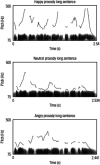Assessment and Treatment of Prosody Behavior in Individuals with Level 1 Autism: A Review and Call for Research
- PMID: 35141105
- PMCID: PMC8789987
- DOI: 10.1007/s40616-021-00154-5
Assessment and Treatment of Prosody Behavior in Individuals with Level 1 Autism: A Review and Call for Research
Abstract
Differences in prosody behavior between individuals with autism spectrum disorder (ASD) and their typically developing peers have been considered a central feature of ASD since the earliest clinical descriptions of the disorder (e.g., Kanner, 1943/1973). Prosody includes pitch and volume among other dimensions of vocal-verbal behavior that discriminate responses of the listener; thus, people with ASD whose prosody has confusing or off-putting effects may have fewer social opportunities at work, at school, or in the community. The purpose of this review is to examine the state of the literature intervening on prosody with individuals with ASD and to provide recommendations for researchers who are interested in contributing to the scientific understanding of prosody.
Keywords: Autism; Conversation; Prosody; social skills.
© Association for Behavior Analysis International 2021.
Conflict of interest statement
Conflict of interestThere were no conflicts of interest.
Figures

References
-
- American Psychiatric Association. (2013). Diagnostic and statistical manual of mental disorders (5th ed.) 10.1176/appi.books.9780890425596.
-
- Boersma, P., & Weenink, D. (2008). Praat: Doing phonetics by computer (Version 5.0.35) [Computer program]. https://www.fon.hum.uva.nl/praat/
Publication types
LinkOut - more resources
Full Text Sources
Miscellaneous

